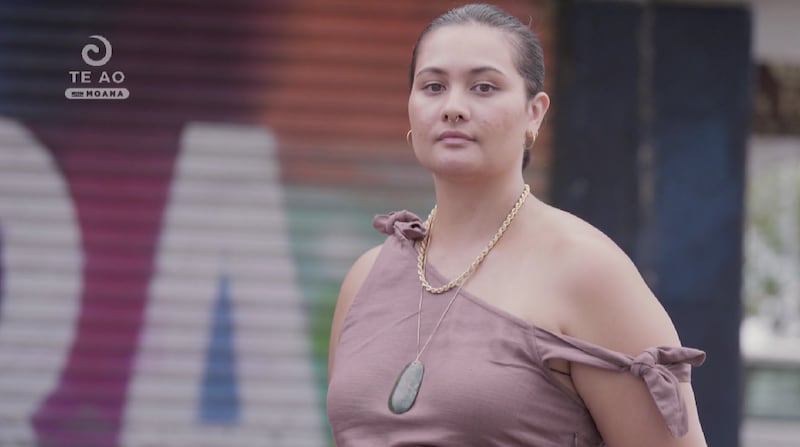Singer Jordan Rapana, also known as Jordyn With a Why, is making her mark, inspiring a whole generation of urban Māori with her music that celebrates te reo Māori.
She creates bilingual music that mixes RnB, soul pop and neo soul. Each waiata is influenced by her own experiences growing up as a Samoan, Māori in an urban setting through indigenous stories, kupu (words) and different musical elements.
Rapana says, “I just want everyone to fall in love with te reo Māori. I want to put it on the biggest platforms that I can find and for people to fall in love with our reo because I think if you fall in love with something, then you can nurture it, you can take care of it a lot better.”
Rapana has been so successful that she was announced as a finalist in the 2025 Aotearoa Music Awards, nominated for Best Māori Artist for her album Hibiscus Moon, Love & Justice and for the Mana Reo award for her waiata Reia.
In 2024 her waiata He Rei Niho won the APRA Maioha Award, which recognises contemporary Māori music and songwriters telling Te Ao Māori stories.
“Te reo Māori is a right for Māori. We should know our reo and we have a right to know it, but it’s also for everyone. Everyone should be learning and understanding or having a bigger heart towards this language because it’s from here, from this whenua.”

Songwriting in te reo is her superpower
Rapana wasn’t raised speaking the language. She learned it after studying a full time, full immersion course at Te Wānanga Takiura o Ngā Kura Kaupapa Māori o Aotearoa.
“It’s offered a window into a whole other world when it comes to songwriting,” she says.
“Using these indigenous stories and indigenous languages within my style of music, it is my superpower, it is my difference, my own kind of style in the space and it really is just leaning into that tuakiritanga, leaning into my identity, as a wahine Māori.”
Rapana was raised in Otara, Auckland under the care of her nan Taulapapa Fuala’au.
“Ataahua rawa atu ia. He wahine māia. He wahine toa. He wahine kītahi. He waimarie katoa mātou ko taku whānau, kua tipu ki te atu i te mana o te wahine.”
“She was so beautiful. She was a brave woman. She was a warrior. She was true to her word. My whānau and I were very lucky to have grown to see her influence as a woman.”
Rapana says she is part of a very matriarchal whānau and her nan was the head of the family.
“She definitely stood for a lot of justice, was very sacrificial, would sacrifice so much so that we could have better opportunities.”
It was from her nan that Rapana learned the values of “aroha ki tō whānau me te pukumahi”, having love for your family and working hard.
“She was such an incredibly hard worker and knew how to have a vision for generations that she didn’t know yet and I think that’s a massive one that guides a lot of the way that I live my life now, not necessarily for just myself, not even just for my children, but for the generations that I don’t know yet.”
Her nan was also the inspiration of her latest album Hibiscus Moon, Love & Justice.
“Every time I see a hibiscus I think about my nana. I love the way that the moon orbits the earth. I think that was her lifestyle and I think that’s who I want to be is someone that rotates and orbits around the idea of love and justice.”
Musicians who paved the way
Growing up, Rapana was inspired by musicians including Che Fu, Aaradhna, Jamoa Jam, and Moana Maniapoto and Dame Hinewhei Mohi who have created music in te reo Māori.
“I think it’s so important to acknowledge that people like me don’t exist in the music industry without all of the hard work that people like Whaea Hinewehi, Whaea Moana have paved.”
Rapana worked with Mohi as part of Waiata Anthems, an initiative that creates compilation albums by New Zealand artists, whereby they re-record songs from English to te reo Māori.
“Waiata Anthems is such a brilliant example of that, just bringing new artists in, or even other legendary iconic New Zealand artists and helping them on their own reo journeys or translating popular songs. I just think it’s been an incredible Kaupapa.”
Songwriting a healing process
Rapana’s first ever waiata Te Ao Marama still resonates strongly. She wrote it after she miscarried her pēpi, baby.
“I tino taumaha tērā wā. Nō reira ko te tito waiata he momo tikanga kia puta tērā pouri.”
“It was a really difficult time. So song-writing was a process to express that grief.”
Rapana says at the time she needed to do something with “a start and a finish”.
“Miscarriage just happens and then you don’t have a tangihanga, you don’t even get time off work, really. You’re just expected to stay home for a couple of days and then get back into it,” she says.
“It turns out that it kind of birthed a whole different life. It really started this whole trajectory of a music career, which was not even a goal.”
Creating the waiata also helped her connect with others who had experienced miscarriage. According to Te Whatu Ora, in Aotearoa a miscarriage can occur in up to one in five pregnancies.
“It connected me to so many other wāhine and at that time I didn’t realize how common it is. It’s so commons and it’s such a universal experience, but it wasn’t as talked about. I think more people have been a lot more open to talking about that in these recent years, which is so beautiful. It just makes it seen, makes you feel less alone because it can be quite a lonely experience.”
Raising their tamariki speaking te reo Māori
Rapana and her husband Thomas have two tamariki, Toa and Pakotāiko. They choose to raise them speaking te reo Māori.
“Teaching and raising our kids in te reo Māori has shifted their idea of what beauty is, their idea of what the world looks like and how they interact with their environment. So I wasn’t really brought up around a lot of tā moko or just seeing that as the epitome of beauty and my son cannot wait for the day that he gets his mataora to be just like his dad or to be just like the tāne that he sees platformed in these Māori spaces. So where you get your heroes from where you get your identity informed.”
Rapana noticed when growing up that te reo Māori was not always valued.
“There was this idea that you make your world smaller if you learn or reclaim reo Māori and, in fact, I’ve just found it was the absolute opposite. It made my world bigger.”
She’s excited to see just how quickly the tide is turning.
“You see so much news, current affairs done in te reo Māori, movies, Disney. I think it’s because there’s less and less room in the world now for the person that thinks that te reo Māori isn’t [valuable] because you can only be ignorant for so long and at that point you’re just walking around with your eyes closed.”

